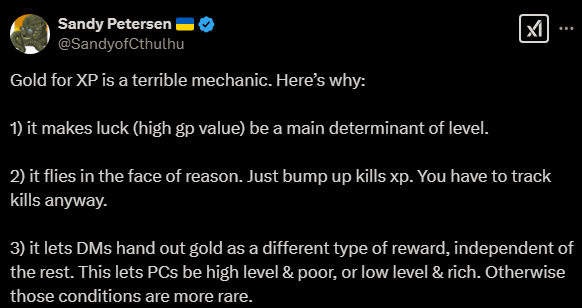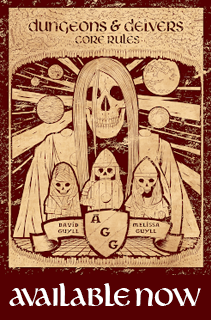Why Yes, XP For Moving Gold Around IS A Terrible Mechanic
(Originally posted on the other blog but forgot to do it here, too.)
I’ve never been a fan of awarding experience points based entirely on a character merely transporting coins, gemstones, and I think magic items from a dungeon environment to some other arbitrary location.
Partially is that it’s not even necessary to encourage a specific playstyle, mostly it’s because the idea of, say, a warrior getting more meat points and perhaps a bonus to his attack rolls—albeit in an unnecessarily convoluted fashion—largely because he was able to lug a chest of gold from point A to B is utterly absurd.
I’m guessing Gary felt similarly as, along with a number of other inane mechanics (and recommendations), it was wisely abandoned from Editions 2 and up, barely making it to optional status once, and even then only for all of one class category.
Anyway, my disdain for such a moronic mechanic is why I was directed to this post over on Twitter:
While Sandy is correct in that it’s an objectively terrible mechanic, I’m not sure exactly what he means with his first point.
When it comes to the classics I’m mostly familiar with 2nd Edition Advanced Dungeons & Dragons, and while you can randomly roll to generate some or all treasure I recall that, regardless of rolls, you’re supposed to make it worth the characters’ while (and reduce it if you think you rolled way too much stuff). Additionally, there’s this part on page 85 of the 1st Edition Dungeon Master’s Guide:
“If the guardian(s) was relatively weaker, award experience on a 5 g.p. to 4 x.P., 3 to 2,2 to 1,3 to 1, or even 4 or more to 1 basis according to the relative strengths. For example, if a 10th level magic-user takes 1,OOO g.p. from 10 kobolds, the relative strengths are about 20 to 1 in favor of the magic-user. (Such strength comparisons are subjective and must be based upon the degree of challenge the Dungeon Master had the monster(s) pose the treasure taker.)”
So…it sounds like that, if the monsters are deemed to be “relatively weaker” the ratio isn’t 1:1. Not sure what it means if you just sneak past them and avoid confrontation entirely, but I find the whole thing hilariously stupid: fighter can lug a chest of 2,000 gold pieces back to town and immediately level up, unless he stole it from some kobolds in which case it might only be arbitrarily worth a half-level or less.
But then in 2nd Edition you didn’t get extra experience based on gold collected (why would you?), unless using an optional rule where rogue-type classes could get some due to cash retrieved (though here you got 2 XP per gold piece instead of 1). We actually did this in one campaign, and despite it meaning that the thief leveled up even faster than usual, leveling up didn’t do much back then so it wasn’t a big deal.
(Something else to note is that in 2nd Edition, the section on experience points mentions awarding some based on player activity, involvement and improvement, character survival, and completing variable and story goals. So, I don’t know why some people pretend that without handing out experience merely for shuffling gold about, the only alternative is killing stuff.)
Now, I do agree with his second point, though would extend this to awarding experience points for a number of different activities—2nd Edition also had some examples for various individual awards not tied to class—which along with some other ideas and tweaks would be a far better way to push a specific playstyle that D&D never did well, anyway.
I also agree with his third point, but would rephrase it to “treasure is its own reward”. As for expected PC wealth by level, dunno about that, as in 1st Edition where this nonsense started—or was at least one of the few versions that relied on it—you usually also had to spend an absurd amount of gold—and time—leveling up for some reason.
That said, in our longest-running 2nd Edition campaign we got to like 12th- or 13th-level and were still quite poor (nowhere near enough for any one character to even begin dreaming of building a castle). But then the DM was kind of stingy and liked rubbing it in our faces when we didn’t find his autistically concealed loot: I count myself lucky that, by the time the campaign fizzled out, I’d somehow managed to find and retain a +2 longsword (the only magic item I can recall besides a +1 sword that was +2 versus undead).
Again, not only is the mechanic terrible and, again, abandoned starting in 2nd Edition, it’s also not even necessary to push a given playstyle, which is the only excuse I see traditionalists/apologists offer in a flimsy attempt to justify its existence:
Tactical considerations centered around extraction, as well as encumbrance, are still factors even if moving gold doesn’t magically make your character tougher, better at swinging a sword, casting spells, etc.
Case in point, in a 3rd Edition campaign, where treasure is its own reward, my players spent hours trying to figure out how to remove iron spheres from a trap that somehow launched them so that they could store and gradually sell them to local smiths.
It certainly helped that this was 3rd Edition, where you could actually spend gold on a number of things besides a trainer. But really all you need to do to motivate players to find loot is give them something worthwhile to do with it. Don’t need to do that and link it to unrelated character advancement.
Smart play can also mitigate combat risks. Additionally, you can award experience points for characters using “smart play” to avoid threats and hazards.
For example, in a ruined keep with some orcs and treasure, the characters can:
Just kick in the door and slaughter them all. Probably the riskiest approach, but also the most direct.
- Lure some out, ambush them, rinse and repeat until all the orcs are dead. Likely safer but more time consuming.
- Throw some oil inside, light in on fire, bar the door, and wait until the orcs have burned to death or at least suffocated. Though this might damage or destroy some of the treasure. Could also be used to get the orcs to flee.
- Slay the orc warchief and get the rest to flee or surrender.
- Just try to sneak in, get the gold in, and leave.
- Sneak in and kill the orcs. Or kill whatever is necessary to get the gold and leave.
This isn’t exhaustive and depends on what the characters have, layout of the keep (as well as size and entrances), orc numbers, defenses, etc.
However, if you still award experience points for sneaking in and out, and it's equal to or nearly the same as killing them, then there is an incentive for taking the nonviolent approach, especially if combat is random and deadly. Also helps if injury isn’t trivially undone, though if we’re talking bog-standard D&D it likely is due to easily accessed-and-replenished, effectively no-strings-attached divine healing.
This, plus awarding experience points for disabling/evading/outright destroying traps, avoiding conflict using words, skill, bribes, etc, rewards players directly for their “smart play”, as opposed to maybe if they happen to get the gold in which case the plan doesn’t matter and the award is arbitrarily linked to the amount of treasure found—and brought back to civilization—rather than how creative/effective the plan was.
It also means that, if something goes awry, the players still get rewarded for smart thinking, even if they don’t get all of the gold, or fail to bring some or all of it back to town for whatever reason. Which is pretty close to how it works in 2nd Edition, especially if you add in those optional individual awards for stuff like clever ideas.















Leave a Comment